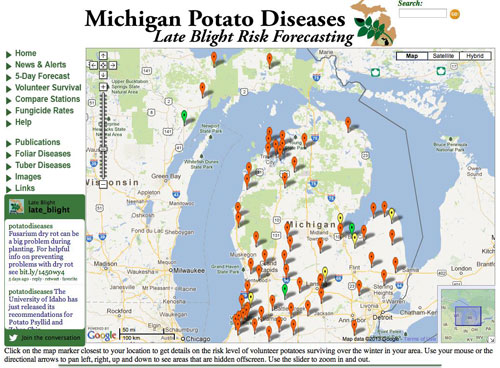Estimating the potential survival of potato volunteers in Michigan
Growers can now estimate potential survival of potato volunteers in Michigan for 2013 risk estimation through the Late Blight Risk Forecasting website.
The Late Blight Risk Forecasting website for estimating potential survival of potato volunteers in Michigan is now available for 2013 risk estimation. Epidemics of potato late blight are initiated from mycelium of P. infestans, which survives between successive growing seasons by overwintering in infected potato tubers intended for seed, as volunteer tubers left in fields at harvest, or within discarded cull and rock piles. With the recent trend for warmer winters, more volunteers and cull pile potatoes are surviving the winter and acting as sources of inoculum in the spring. It is difficult to estimate the probability that infected potato stems will emerge from an infected tuber and several factors can influence the fate of the infected tuber, temperature being one of the most important.
By clicking on a colored tab on the website, you will be directed to the following explanation: “What is volunteer survival?”
Potatoes that are left in the field at harvest are known as volunteer potatoes. In areas where winter soil temperatures are not cold enough to kill tubers left in the field, they can survive the winter and become a serious weed problem the following spring. In addition, volunteer potatoes that survive the winter can harbor pests and diseases. Epidemics of potato late blight can be initiated from mycelium of Phytophthora infestans, which survives over winter in infected volunteer potatoes. Studies at Michigan State University have shown that tubers of most cultivars appear to break down after exposure to 27 degrees Fahrenheit for about one day.
We have developed a model that predicts the likelihood of tuber survival over the winter based on soil temperatures at 2 and 4 inches between Nov. 1and March 31.
- If tubers were exposed to temperatures below 27 F for more than 120 hours between Nov. 1 and March 31 at 4 and 2 inches deep, then the risk of tuber survival is considered low (indicated by a green marker pin).
- If tubers were exposed to temperatures below 27 F for less than 120 hours at 4 inches deep and greater than 120 hours at 2 inches deep, then there was a moderate risk of tuber survival (indicated by a yellow marker pin).
- If tubers were exposed to temperatures below 27 F for less than 120 hours at 4 inches deep and less than 120 hours at 2 inches deep, then there was a high risk of tuber survival (indicated by an orange marker pin).

Estimated risk of volunteer potato survival at various Enviro-weather
locations in Michigan based on hours of exposure below 27 F.
After the 2012-13 winter, most regions experienced soil thermal conditions that placed them in the high-risk category for volunteer survival. Only Stephenson, Mich. (Menominee County), Bay County and Hastings, Mich., in Barry County were at low risk, and Grand Junction, Mich. (Van Buren County), Bath, Mich. (Clinton County), Linwood, Mich. (Bay County), Richville, Mich. (Saginaw County) and Verona, Mich. (Tuscola County) had moderate risk of potato volunteer survival. This situation should alert potato growers to the high risk of potato volunteers surviving the winter and all growers should, therefore, be implementing their integrated pest management scouting programs early in 2013 and considering volunteer elimination programs in adjacent, non-potato crops if herbicides are registered.



 Print
Print Email
Email

